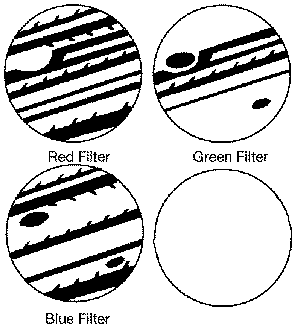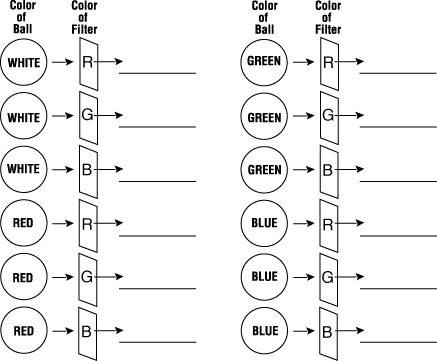Students will experiment with color filters and be guided towards deriving the process by which HST converts B&W images into color pictures.
Engage
Materials
Note: since this Guide is only black and white, before beginning the Activity, please prepare the answer by coloring-in the hypothetical planet as suggested by the
color code. "Please try to keep within the lines!"
Explore/Explain
Procedure
When students have completed their charts, distribute red, green and blue marking pens. Explain that these show three images of the same simplified and hypothetical
planet. All the images are black and white, but each appears as if taken through the different color filters, as indicated. Using marking pens and their chart as a guide,
ask students to study the three black and white images carefully, and then draw an image in color showing what they think the planet really looks like. When they are
done, show students the correct answer you have prepared in advance, and guide them to appreciate the reasons why.
Expand
Light, color and the effects of colored filters
Normal sunlight and most classroom lighting is "white light," meaning it contains all colors of the spectrum. Opaque objects appear the color they do when illuminated
by white light because their surfaces scatter only certain colors back into our eyes. A white object appears white because it scatters all the colors which together
make white light. A pure black object appears black because its surface absorbs all the light which falls on it and scatters none of it back into our eyes. An object
looks red because it scatters only the red rays in white light back into our eyes.
Colored filters only allow light of their particular color to pass through. Thus a red filter only allows red light to pass through; a green filter only green light. So a white
object (which scatters all colors of light), will look the color of whatever filter it is seen through: red through a red filter, green through a green filter. A black object
scatters no light, so it will look black through any color filter. A red object will look red through a red filter, but black (or gray) through a green or blue filter, because
the object only gives off red light. Similarly, a green object will look green through a green filter, but black (or gray) through a red or blue filter. A blue object will
look blue through a blue filter but black (or gray) through a red or green filter.
Note: depending on the exact color of red, blue and green in the images you use, and the exact color of the markers, crayons or pencils available to students, you
will get more or less the "ideal" results described above. A red object through the blue filter may appear gray rather than pure black, but students should still be able
to grasp the basic principles.
In this Activity, you and your Data Analysis Team are going to create a color image of a planet, beginning with just three black and white images as clues to its "real"
appearance. It's a fancy piece of detective work. Your teacher will distribute color filters to your Team and ask you to examine samples of paper which are white,
black, red, green and blue through the filters. Fill in the boxes in the Chart below with the color that each of these objects appears when seen through each of the
different filters.
Study the diagram below. Each shows light from objects of a different color passing through different-colored filters. Apply what you learned from your "eyes-on"
experiment, and fill in the blank space with the color which you think passes through the filter. This is the color the object will appear if it's seen through that filter. If
you think that no color would pass through, write "none." This means the object would look black through that filter.
Below are three black and white images of a hypothetical planet. Each simulated image appears as if it was taken through the different color filter noted under the
image. Examine these images carefully and applying the rules you generated, figure out the real colors of the planet's features. Using colored pens or markers, create
a color drawing of the planet in the blank circle below.
Filter Color
Microsoft Word Format
Show students some of the stunning HST color images, such as those of M-16, the Eagle Nebula (which also appears on the poster co-packaged with this Guide.)
Ask the students if they realize that the HST can only "see" in black and white. Ask them how they think such color images are created.
(for each team: color filters may need to be shared)
• set of three color filters (red, green and blue), co-packaged with this Guide
• copies of the student worksheet, providing simulated black and white views of a hypothetical planet, as if taken through red, green and blue filters
• black, red, green and blue paper or other test objects or material (matching their color as closely as possible to that of provided colored filters)
• markers and crayons of colors chosen to match the filters
Explain that scientists use computers to create color images from HST and other spacecraft by combining information from several black and white images taken
through different colored filters. Explain that this is because objects reveal different aspects of their surfaces through filters of different colors. In this Activity, students
will be able to explore this phenomenon for themselves, and then deduce the "real" colors of a hypothetical planet, working only from black and white images-just
like NASA's computers. (To repeat, the planet is hypothetical and, for clarity's sake, composed only of primary colors but the same principles and procedures apply
to any image of any color or hue.)
Use the section below (Light, color and the effects of colored filters) as necessary to help explain the theory of why objects look the colors they do under
white light and through filters of different colors. Pass out the sets of red, green and blue filters to each team. Have students look through their filters at pieces of
paper that are white, black, red, green and blue, and fill in the chart on their worksheets in which they describe the color these objects appear, with and without the
filte rs.
Have students apply the principles of this Activity to create "Hidden Messages" which can only be detected using filters of the appropriate color.
Use the red, green and blue filters and others you can obtain or borrow to allow your students to
explore the properties of light and filters for themselves, before you begin the activity. Have
them use the enclosed HST lithographs and other color images for their experiments. Guide them to
discovering the principles they'll use to transform black and white data into color pictures.
 Your planet to color
Your planet to color

Student Worksheet - Microsoft Word Format
PDF Version
Student Worksheet - PDF Version
![]()